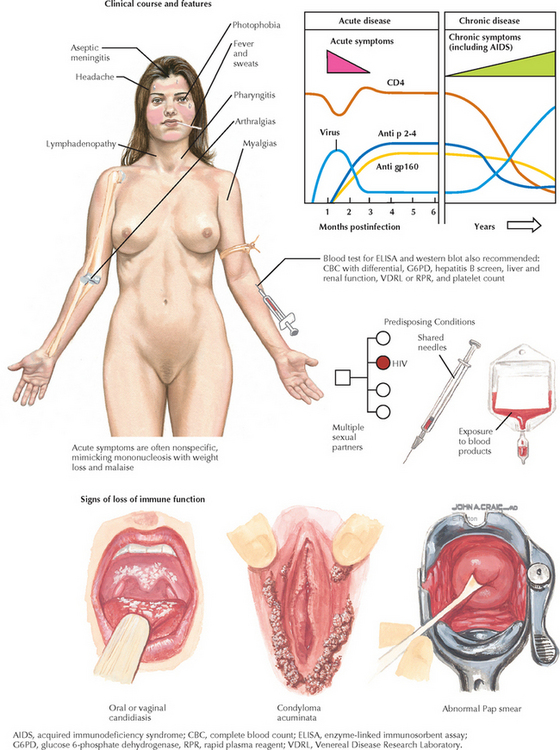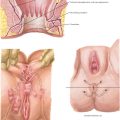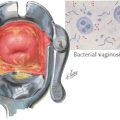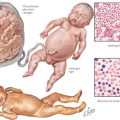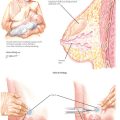Chapter 51 Sexually Transmitted Infections: Human Immunodeficiency Virus
INTRODUCTION
ETIOLOGY AND PATHOGENESIS
CLINICAL CHARACTERISTICS
Signs and Symptoms
DIAGNOSTIC APPROACH
Workup and Evaluation
MANAGEMENT AND THERAPY
Nonpharmacologic
Drug(s) of Choice
FOLLOW-UP
MISCELLANEOUS
Catanzaro AT, Koup RA, Roederer M, et alVaccine Research Center 006 Study Team. Phase 1 safety and immunogenicity evaluation of a multiclade HIV-1 candidate vaccine delivered by a replication-defective recombinant adenovirus vector. J Infect Dis. 2006;194:1638. Epub 2006 Nov 8
Gallant JE, DeJesus E, Arribas JR, et alStudy 934 Group, Tenofovir DF. emtricitabine, and efavirenz vs. zidovudine, lamivudine, and efavirenz for HIV. N Engl J Med. 2006;354:251.
Gulick RM, Ribaudo HJ, Shikuma CM, et alAIDS Clinical Trials Group (ACTG) A5095 Study Team. Three- vs four-drug antiretroviral regimens for the initial treatment of HIV-1 infection: a randomized controlled trial. JAMA. 2006;296:769.
Hurwitz BE, Klaus JR, Llabre MM, et al. Suppression of human immunodeficiency virus type 1 viral load with selenium supplementation: a randomized controlled trial. Arch Intern Med. 2007;167:148.
Lockman S, Shapiro RL, Smeaton LM, et al. Response to antiretroviral therapy after a single, peripartum dose of nevirapine. N Engl J Med. 2007;356:135.
Pitisuttithum P, Gilbert P, Gurwith M, et alBangkok Vaccine Evaluation Group. Randomized, double-blind, placebo-controlled efficacy trial of a bivalent recombinant glycoprotein 120 HIV-1 vaccine among injection drug users in Bangkok, Thailand. J Infect Dis. 2006;194:1661. Epub 2006 Nov 3
Nagot N, Ouedraogo A, Foulongne V, et alANRS 1285 Study Group. Reduction of HIV-1 RNA levels with therapy to suppress herpes simplex virus. N Engl J Med. 2007;356:790.
Pilcher CD, Eron JJJr, Vemazza PL, et al. Sexual transmission during the incubation period of primary HIV infection. JAMA. 2001;286:1713.
Strategies for Management of Antiretroviral Therapy (SMART) Study Group, El-Sadr WM, Lundgren JD, Neaton JD, et al. CD4+ count-guided interruption of antiretroviral treatment. N Engl J Med. 2006;355:2283.
Waller SC. A meta-analysis of condom effectiveness in reducing sexually transmitted HIV. Soc Sci Med. 1993;36:1635.
Wawer MJ, Gray RH, Sewankambo NK, et al. Rates of HIV-1 transmission per coital act, by stage of HIV-1 infection, in Rakai, Uganda. J Infect Dis. 2005;191:1403.
Bardequez AD. Management of HIV infection for the childbearing age woman. Clin Obstet Gynecol. 1996;39:344.
Centers for Disease Control and Prevention. Sexually transmitted diseases treatment guidelines, 2006. MMWR. 2006;55:10.
Letvin NL. Progress in the development of an HIV-1 vaccine. Science. 1998;280:1875.
Panel on Antiretroviral Guidelines for Adult and Adolescents Guidelines for the use of antiretroviral agents in HIV-infected adults and adolescents 2006 Department of Health and Human Services 1 Available at http://www.aidsinfo.nih.gov/ContentFiles/AdultandAdolescentsGL.pdf Accessed June 1, 2007.
Piot P. AIDS: from crisis management to sustained strategic response. Lancet. 2006;368:526.
Simon V, Ho DD, Abdool Karim Q. HIV/AIDS epidemiology, pathogenesis, prevention, and treatment. Lancet. 2006;368:489.
U.S. Department of Health and Human Services Treatment of opportunistic infections 2006 U.S. Department of Health and Human Services, National Institutes of Health, CDC Washington, DC Available at http://www.aidsinfo.nih.gov Accessed June 1, 2007.

